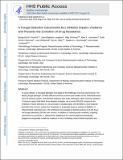A Fungal-Selective Cytochrome bc₁ Inhibitor Impairs Virulence and Prevents the Evolution of Drug Resistance
Author(s)
Srinivas, Raja; Lancaster, Alex K.; Scherz-Shouval, Ruth; Whitesell, Luke; Vincent, Benjamin Matteson; Langlois, Jean-Baptiste; Tidor, Bruce; Buchwald, Stephen Leffler; Lindquist, Susan; ... Show more Show less
DownloadA fungal-selective.pdf (1.599Mb)
PUBLISHER_CC
Publisher with Creative Commons License
Creative Commons Attribution
Terms of use
Metadata
Show full item recordAbstract
To cause disease, a microbial pathogen must adapt to the challenges of its host environment. The leading fungal pathogen Candida albicans colonizes nutrient-poor bodily niches, withstands attack from the immune system, and tolerates treatment with azole antifungals, often evolving resistance. To discover agents that block these adaptive strategies, we screened 300,000 compounds for inhibition of azole tolerance in a drug-resistant Candida isolate. We identified a novel indazole derivative that converts azoles from fungistatic to fungicidal drugs by selective inhibition of mitochondrial cytochrome bc1. We synthesized 103 analogs to optimize potency (half maximal inhibitory concentration 0.4 μM) and fungal selectivity (28-fold over human). In addition to reducing azole resistance, targeting cytochrome bc₁ prevents C. albicans from adapting to the nutrient-deprived macrophage phagosome and greatly curtails its virulence in mice. Inhibiting mitochondrial respiration and restricting metabolic flexibility with this synthetically tractable chemotype provides an attractive therapeutic strategy to limit both fungal virulence and drug resistance.
Date issued
2016-08Department
Massachusetts Institute of Technology. Department of Biological Engineering; Massachusetts Institute of Technology. Department of Biology; Massachusetts Institute of Technology. Department of Chemistry; Massachusetts Institute of Technology. Department of Electrical Engineering and Computer ScienceJournal
Cell Chemical Biology
Publisher
Elsevier
Citation
Vincent, Benjamin M. et al. “A Fungal-Selective Cytochrome bc₁ Inhibitor Impairs Virulence and Prevents the Evolution of Drug Resistance.” Cell Chemical Biology 23, 8 (August 2016): 978–991 © 2016 Elsevier Ltd
Version: Author's final manuscript
ISSN
2451-9456